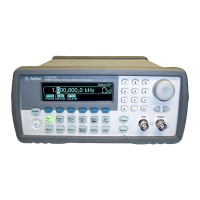341
Chapter 7 Tutorial
Modulation
4
7
Pulse Width Modulation (PWM) PWM is used in digital audio
applications, motor control circuitry, switching power supplies, and other
control applications. The Agilent 33220A provides PWM for pulse
waveforms, and PWM is the only type of modulation supported for pulse
waveforms. For PWM, the amplitude of the modulating waveform is
sampled digitally and used to control the pulse width or duty cycle of the
pulse waveform.
Pulse Width Modulation
The variation of pulse width in the modulated waveform from the pulse
width of the pulse waveform is called the width deviation. The deviation
can also be expressed in terms of duty cycle (as a percentage referenced
to the period of the pulse waveform), which is called the duty cycle
deviation. In PWM the deviation of width or duty cycle is symmetrical
around the pulse width or duty cycle of the original pulse waveform. For
example, if you specify a pulse waveform with a 10% duty cycle, and then
specify PWM with a duty cycle deviation of 5%, the modulated waveform
will have a pulse that varies in duty cycle from 5% to 15% under control
of the modulating waveform.
Modulating Signal
Modulated Waveform

